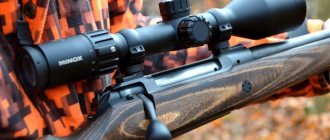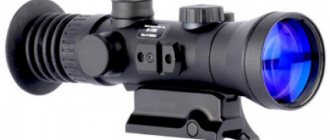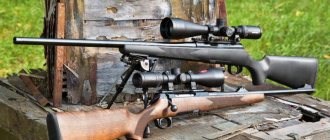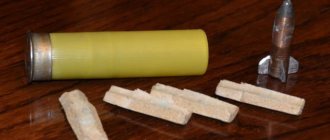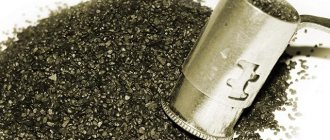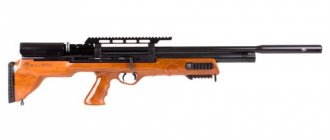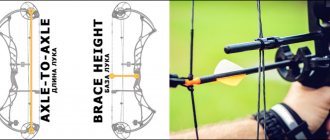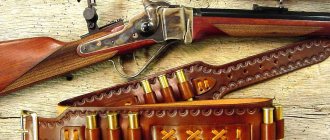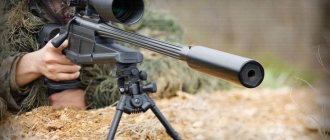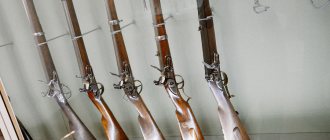ORSIS hunting rifles are for those who dream of conquering the world, challenge nature and cannot imagine life without vivid impressions. The ORSIS rifle range represents its own unique developments, which can satisfy the needs of the most demanding hunters. Models in this series have repeatedly proven their exceptional durability and performance in a variety of situations: under the scorching sun of Africa, in extreme Russian frosts and in conditions of high humidity in the tropics. That is why ORSIS rifles are ideal for both experienced and novice shooters for any type of hunting: classic, mountain or safari.
ORSIS SE Hunter
Purpose: Hunting
On request
Basic price
More detailsWhere to buy
The rifle (rifled hunting carbine) ORSIS Hunter is designed for various types of hunting. The rifle with manual reloading is made on the basis of a multi-shot bolt group with two front lugs. ORSIS Hunter rifle for left-handed and right-handed people.
Weapons for hunting in the mountains
19.01.2011
What do you go hunting with in the mountains? The question is as rhetorical as it is voluminous and complex. Hunting in the mountains is one of the most difficult types of hunting. These hunts are difficult due to many circumstances. First of all, mountains are an environment hostile to human life. Low atmospheric pressure, low oxygen content in the atmosphere, increased solar radiation, extreme temperatures. This is all that awaits the hunter while hunting ibex, rams and other mountain inhabitants. For these reasons, the price of a shot fired by a hunter at an honorable trophy, regardless of its size, is also high. And for this shot to be successful, it is necessary, first of all, to have in your hands at that moment good weapons and ammunition that can not only hit, but also stop a mountain animal that is susceptible to wounds.
Hunting conditions
At the same time, it would be a mistake to consider hunting in the mountains only through the prism of an aimed and accurate shot. There are no trifles in mountain hunting, and the same well-aimed shot is more likely the final stage of a complex and long path to the goal, rather than simply hitting the target. I would divide mountain hunting into two main types. The first includes hunting in the mountains at altitudes up to 3000 meters above sea level. The second type of mountain hunts will include hunts at altitudes above 3000 meters. Why this division? The reason is simple. At altitudes up to 3000 meters, a well-prepared body practically does not feel the influence of altitude. The oxygen content does not have any noticeable negative effect on the functioning of the musculoskeletal system and the cardiovascular system. But on these hunts, the physical exertion is sometimes prohibitive due to the difficult mountain landscape and very steep mountain slopes. In this category I would include hunting in the Caucasus for aurochs and chamois, for bighorn sheep in Kamchatka, Yakutia, Primorye and in the Magadan region, hunting for bear, ibex in the Sayan Mountains and ibex in the Altai Mountains. When hunting at altitudes above 3000 meters, the body is exposed to many external factors. First of all, this is hypoxia, in which the hunter is haunted by nausea, pounding in the temples, and shortness of breath appears after a short walk. These negative effects of altitude can have a significant impact on shot accuracy. When hunting in such conditions, you don’t have to walk as much, since movement is mainly carried out on horses or in cars.
Considering all the difficulties that await a hunter on mountain hunts, a serious question arises: what to do with such a responsible hunt, where every shot can be worth its weight in gold?
Hunting is a creative process and does not depend on one person. There are outfitters, there are local organizers - owners of hunting grounds, and, finally, there are guides. A lot depends on the latter in mountain hunting. And how closely the guide can understand and feel the hunter will depend on how close he can bring the hunter to the shooting position. And this fact alone will make it possible to determine how correctly the weapon and cartridges were chosen for this type of mountain hunting.
It is necessary to immediately divide hunters into those who already have experience in mountain hunting and beginners. Those who like to shoot at an animal from extreme distances, and those who prefer to walk the path and experience the sensations that are characteristic of close contact with the animal. Ultimately, the choice of weapon will be determined by these factors. I will nevertheless take the liberty, based on the experience of mountain hunting, personal moral and ethical principles and rules of hunting, to give recommendations to those hunters who, in addition to possessing an honorary trophy, would like to leave in their memory both observations of the animal in its natural habitat, and unforgettable impressions of hiding the beast, and, of course, entering the shooting position and the shot itself. In the memory of any trophy I have captured, the process of approaching the animal and preparing for shooting always occupies a significant place.
Calibers and bullets
When choosing a weapon for mountain hunting, you must first of all take into account the fact that almost all mountain animals are very resistant to wounds. Even a mortally wounded ibex or ram can go far into the rocks and be lost by hunters as a trophy. Therefore, the widely held opinion that when choosing a weapon for mountain hunting it is necessary to be guided by the principle of range and flatness is unlikely to stand up to criticism. Typically, 7 mm RemMag and similar calibers have good flatness characteristics. You can hunt the same ibex, for example, with caliber 243 Win, and quite successfully, But... this can only apply to very experienced mountain hunters who can literally walk up to the animal and “scratch it behind the ear.” At a short distance of up to 50 or even 100 meters, a 243 Win caliber bullet that hits an animal in the neck or behind the ear will not give it any chance. But very few people can make such a shot. Therefore, when choosing the caliber of a weapon and cartridge, we will be guided by considerations about the need to stop the beast at distances of up to 300-350 meters. It is at this distance that the bullet’s flight path is most predictable, and the impact of the energy remaining at such a distance will be sufficient to prevent the animal from going far. I would not like to dwell particularly on weapons manufacturers, so as not to offend some and not advertise to others. We will talk mainly about calibers, bullet weight and energy. One way or another, a cartridge with specified characteristics was always developed first, and a carbine was made for it. In addition, having a clear understanding of the characteristics of the cartridge, choosing the carbine itself will be much easier. There are adherents of Blaser carbines, some prefer Mannlicher, others go hunting only with Sako carbines; CZ carbines are very popular and have a good price/quality ratio. You can argue until you are hoarse about the advantages and disadvantages of any of the carbines produced by the above and other companies, but we will not do this. We have other goals at the moment, and we are talking about the optimal weapon for hunting in the mountains.
Our starting point is the cartridge. When evaluating a cartridge and a bullet, we will focus on two main indicators that are decisive for defeat and, most importantly, for stopping the beast. I mean persistence and the amount of energy delivered by a bullet at a distance of 300 meters.
It is impossible not to note the light mountain calibers. I would still like to note the 243 Winchester caliber cartridge. Equipped with a semi-jacketed Teilmantel-S bullet weighing 6.48 grams, produced by Norma, brings 1462 J at 300 meters and has a deviation from the aiming line at the same 300 meters of only 22.7 cm at the GEE or MRD point (optimal shooting distance) at 200 meters. Such a cartridge will make it possible to hunt small animals, such as chamois, roe deer, in the mountains and on flat terrain. For hunting larger animals - aurochs, ibex, bighorn sheep - the minimum can be considered a very interesting caliber 6.5x68 with a bullet weighing 8.16 grams from RWS, delivering 2049 J at 300 meters and falling only 20.4 cm from aiming lines. With such energy and accurate shooting, all of the above-mentioned animals can become trophies in the hands of an accurate and experienced hunter.
I consider it necessary to highlight the various options for the 7 mm cartridge. Why? The cartridge is very unique. Despite their apparent power and persistence, some cartridges of this caliber do not have sufficient energy to reliably stop mountain animals that are resistant to wounds. Let me give you a few examples.
While hunting Siberian roe deer in the Altai Mountains, the hunter fired an accurate shot at a good trophy male using a 7 mm Rem Ultra Mag caliber carbine. At a distance of 100 meters, the bullet passed right through the animal. The hit was on the front part of the body. The animal disappeared behind a ridge and then into dense bushes. Despite our long search, the beast was never found. The same hunter a little later used the same carbine to shoot at a deer. Three shots were fired from a distance of about 120 meters. All three hit the target, but the animal stood, then disappeared into the thickets and was found with great difficulty. In both cases, the bullets pierced the animal's body, without leaving enough energy there to confidently stop the animal. With the same caliber, and also with a Kieplauf breakaway carbine, when hunting ibex in the mountains of Kyrgyzstan, my hunters made several wounded wounded animals of beautiful trophy males. One wounded animal had even visible entrails falling out of its wound, but we only managed to get it the next day. We never found the other two.
The use of these calibers in mountain hunting is negatively affected by factors such as weak energy delivered by the bullet at a distance of 300 meters and beyond; a large deviation of the bullet trajectory from the aiming line at a distance of 300 meters (on average from 26 to 41 cm) with the GEE point on average from 165 to 180 meters. Only a few 7mm cartridges can be considered positive. This is a 7x64 Sako with a Teilmantel-S bullet weighing 11.02 g with an energy of 2430 J and a deviation from the aiming line of 32 cm with a GEE of 175 meters; 7 mm Remington Magnum from Federal Premium with a Nosler 10.37 g bullet, carrying 2715 J with a deviation from the aiming line of only 26 cm at a distance of 300 meters with a GEE of 179 meters.
Speaking of 300 calibers, I would like, based on personal experience, to give a reservedly negative assessment of 30-06 Springfield caliber cartridges; 308 Winchester; .30/30 Winchester and others of a similar category, including 7.62x39; 7.62×54. The only exceptions will be the caliber 308 Norma Magnum with a TXP bullet weighing 11.66 g, an energy of 2914 J and a deviation from the aiming line of 30 cm at a distance of 300 meters and the caliber 30-06 Springfield from Hirtenberger with a Nosler bullet weighing 9.72 g, delivering 2258 J and deviating from the aiming line at 300 meters by only 25.5 cm.
Experienced mountain hunters practically do not use these cartridges on serious trophy hunts. There are obviously several reasons for this. The main reason is that cartridges of this category deliver too little energy at distances of 300 meters or more. The flatness characteristics of these cartridges also deteriorate sharply after 300 meters. I have almost never met serious mountain hunters who would take carbines of the above calibers into the mountains.
And now I would like to draw the readers’ attention to the most versatile and widespread caliber among mountain hunters. We will talk about 300 Winchester Magnum cartridges; 300 Weatherby Magnum and similar. Why are these calibers given so much attention? First of all, they faithfully served and continue to serve those inquisitive hunters who are looking for a worthy trophy when hunting in the mountains. At the same time, hunters of this category, in addition to a beautiful shot, want to learn the intriguing mystery of the entire process of mountain hunting, tracking, hiding the animal, entering the shooting position, preparing to shoot, aiming and the shot itself. It is this category of people that makes up the main backbone of mountain hunters. These are the people who go to the mountains in order to see how capricorns or rams behave in a herd among their relatives, how their relationships are built, how a proud leader, who was tracked down by a hunter with a guide, defends his status quo, how steam flows from the nostrils of a trophy male excited by natural passion. There were cases when a hunter, mesmerized by this natural spectacle, for a moment simply forgot that he was hunting and had come to get a trophy. All this perception of the process is possible at distances from 10-15 to 300 meters. At greater distances, the world of living nature is perceived as a kind of documentary film, and the acuity of sensations is no longer the same. It is this category of hunters who prefer to use reliably proven 300 calibers for mountain hunting.
Why are these calibers attractive for mountain hunting? First of all, almost all cartridges of these calibers deliver about 3000 J or even more with a bullet at a distance of 300 meters, which significantly affects the stopping effect of the bullet. The second thing is that with an average bullet weight of about 11 grams, their deviation from the aiming line is on average 20-30 cm with a GEE of 180 to 200 meters. As we can see from the above data, the hunter has every chance even at distances of 300 meters and a little further to confidently get his trophy. There are cases that a trophy ibex or ram stands at a distance of 350-370, or even 400 meters. But the trophy is truly worthwhile. And it is these calibers that will allow you to make an accurate shot and stop the beast, using all your shooting skills.
I consider it necessary to highlight some 300-caliber cartridges: Winchester with Teilmantel-S 11.66 gram bullet; 300 Weatherby Magnum from Federal Premium Safari with Nosler, Trophy bonded bullets weighing 11.66 grams. The 300 Winchester Sport Magnum cartridge also has good characteristics. Along with this, we will have to make a reservation about the 300 Weatherby Magnum calibers. With very good shooting characteristics, the cartridge is very hard and makes itself felt in the hunter’s shoulder with every shot.
Separately, I would like to note two calibers that are similar in many respects. These are .300 Remington Ultra Magnum and 8x68 S. These two calibers are characterized, in my opinion, by ultra-high energy. Even at a distance of about 300 meters, bullets carry more than 3000 J. When hunting with carbines of such calibers, wounded wounds are common due to the fact that the bullets simply pierced the animal without having time to give off energy. During one of their hunts for a Dagestan tur, a bullet of 8x68 S caliber pierced right through a good trophy tur at a distance of 280 meters. The tour disappeared from sight. For this reason, a lot of time was spent collecting the wounded animal, which fell on the opposite side of the mountain range from us. Approximately the same situation occurs when firing the 300 Remington Ultra Magnum cartridge.
One more detail deserves attention when shooting in the mountains. Even if you give priority to any caliber, you should be very careful when choosing a bullet. Moreover, in addition to indicators of weight, delivered energy and flatness, you should always pay special attention to the ability of the bullet to deliver this energy. In this aspect, the hunting experience with the CDP (Controlled Deformation Process) bullet jointly produced by RWS and Blaser is indicative. With a bullet weight of 10.7 grams, it delivers 2627 J at a distance of 300 meters and deviates from the aiming line by only 20 cm at a GEE of 200 meters. Many of my hunter friends confirm that this bullet is very effective on trophy hunts due to the fact that it begins to release its energy immediately after touching the animal’s skin. This is one of the most valuable qualities of a hunting bullet. I noticed a cartridge with such a bullet several years ago at one of the hunting exhibitions in Moscow. Then I received more detailed information about this bullet from a representative of the Blaser company at an exhibition in Salzburg. It was there that I learned that the V-shaped partition located inside the bullet, due to its flexibility, makes the seal of the bullet in the barrel optimal.
And the entire design of the bullet is designed to regulate the process of unfolding the upper part, which makes this bullet significantly different from, say, the similar Swift A Frame bullet from Norma, which I shot before CDP. The representative also told me that when an experimental shot was fired at a piece of soap 50 cm thick, after studying the bullet channel it turned out that the bullet began to open as soon as it touched the soft structure. And this bullet always opens into four petals, which, in addition to the usual dynamic pressure, also cut the flesh with their sharp edges of the petals, causing profuse blood loss. In all my mountain shooting practice, I have never had to shoot an animal more than once using this cartridge. And even when hunting on the plain, such large animals as the Yakut and Kamchatka moose lay down after the first shot. With the same bullet and also in one shot, bighorn sheep, ibex, and deer were killed.
Optics
Optics in mountain hunting naturally also plays a big role. It is the optics that allow the hunter to clearly see his target. I would like to briefly describe the requirements for an optical sight for mountain hunting. The choice of sights provided by modern companies is quite wide. Each hunter must determine for himself what he likes best and is suitable for his method of hunting and preferred shooting distance. Desirable requirements for a sight can be defined as follows: magnification from 4.5 to 14 or 20. It should be borne in mind that as the magnification increases, the viewing angle significantly decreases and it will be more difficult to catch the target in the crosshairs. The Paralax device will be very helpful when shooting, especially for people with visual impairments. It allows you to focus the target image at 50 or 100 meters, and also at 300 meters and beyond. You can always see your goal clearly.
In my opinion, it is also necessary to have an illuminated crosshair or dot in the scope you choose. The illuminated mark will give you the opportunity, without losing sight of the target, to focus on the aiming point. Illumination is especially relevant in conditions of fog, dust haze, and twilight.
Bipods and additional equipment
From my experience of mountain hunting, an unequivocal conclusion follows that you can absolutely safely do without a bipod on mountain hunting. The basis for this conclusion is the following. A true mountain hunter knows the value of a good trophy. The path we take to achieve a high-quality trophy is fraught with many difficulties. One of the main things is to get to the places where the trophy animal lives. It should be taken into account that males with high-quality trophies are always located above the main herd (except for the rutting period).
When climbing to sky-high heights, you will feel every extra gram of your luggage. On such difficult routes as when hunting Caucasian aurochs and Kamchatka and Yakut bighorn sheep, you will be simply happy if you simply climb to the heights where aurochs and sheep live. You are forced to carry the hunting equipment and food necessary to survive in the mountains. And believe me, the need to carry equipment that you can do without will not inspire you. The routes we took in these mountains, according to local guides, can only be passed by only a few out of a hundred hunters. Any additional equipment will make itself known to you immediately. Moreover, there is no urgent need to carry extra weight on yourself if there are very few situations when you can safely use a bipod. This is due to the fact that almost always when approaching an animal, you cannot appear from behind the ridge behind which the animals are located until the very last moment. Therefore, you have practically no opportunity to calmly install a bipod on rocky ground. But as soon as you want to take advantage of this opportunity, you risk being discovered by animals. The vision of mountain animals is sharp, and they are able to notice the slightest movement at a great distance, and then your attempt to make an accurate shot is doomed.
You can always use your running backpack or jacket instead of a bipod. I always carry my rifle on difficult hunts in a soft cloth case. Such a gun case weighs extremely little, but you are always sure that your carbine is in full combat readiness, the optics, as well as the bolt, are not clogged with dust or dirt. Another great advantage of such a case is that it can always be placed under the carabiner on any type of surface, including sharp stones. In this case, you can achieve good stability of the carbine in any position and, most importantly, minimize the possibility of being detected by an animal. Local guides never liked my case because, according to them, you won’t have time to shoot when an animal suddenly appears. Believe me, this is all nonsense. There has never been a single case when I did not have time to remove my case from the carbine and fire a shot. But I am always confident in my weapon.
This case is indicative. When hunting in the mountains of Kyrgyzstan at an altitude of 4300 meters above sea level. for seven days we were extremely exhausted. We were plagued by failures. We spent the night in the mountains at a temperature of about minus 20 °C. And just before packing up for the return trip, we accidentally saw two ibex on the slope of the ridge. It took about an hour to approach the ibex. During this time I practically did not see any animals. Our guide led me, periodically carefully looking out from behind the rocks and monitoring the location of the ibex. I didn't see them throughout the entire route. At the last moment, I folded my case, put it on the stones, put the carbine on the case and crawled out onto a small shelf to take a shooting position. I put my cheek to the butt and only then did I see two ibex on the slope of a ridge at a distance of 200 meters. The case gave me the opportunity to silently and conveniently position the carabiner. Two shots, and two ibex, defeated, rolled down the slope.
The reader may wonder: what do I shoot with? What kind of carbine and what optics do I take with me to the mountains? For several years now, the Finnish Sako 75 Hunter carbine in De Lux caliber 300 Winchester Magnum has served me faithfully. It is equipped with Leupold Vari X 111 4.5x14x50 optics. There is also parallax and crosshair illumination. Lately I've been using the 10.7g CDP ammo made by RWS in conjunction with Blaser. There are bipods, but I don’t use them simply because they are unnecessary.
Psychology and...
In conclusion, we will try to summarize why and what weapon is most suitable for a hunter on mountain hunts, provided that he is physically prepared and psychologically resilient. The last factor is also important. An example from practical hunting in the mountains of Khakassia. The Bundeswehr sniper was unable to hit a large deer from a distance of 180 meters, which was standing sideways to him. At the same time, out of excitement, this sniper chattered his teeth so much that for some time I could not even determine what or who could make such a strange sound. Summarizing all of the above, we can conclude that the main task when hunting in the mountains is to stop an animal that can withstand a wound! Each hunter must choose a weapon and caliber based on his idea of hunting in the mountains. Analysis of calibers and bullets allows us to come to the following conclusion: close to ideal for all categories of trophy mountain hunting could be a carbine of caliber 30-378 Weatherby with a Nosler bullet weighing 12.96 grams, delivering 4483 J at a distance of 300 meters and deviating from the aiming line of just by 17.7 cm at GEE 201 m.
But in general, I would like to note that in mountain hunting it is important not only the weapon with which you go to the mountains, but also a whole range of factors that influence success. Among them, first of all, is the state of health, physical fitness, psychological and volitional stability, and the high moral and ethical level of the hunter. And never forget that a real mountain hunter sometimes goes where even special forces soldiers do not go. But real mountain hunting is a much more extensive process than a scholastic shot with the aim of obtaining a trophy.
May good luck accompany you!
ORSIS SE Alpine
Purpose: Hunting
On request
Basic price
More detailsWhere to buy
ORSIS SE Alpine is specially designed for mountain hunting and shooting at medium and long distances. Designed for extreme conditions, the rifle is manufactured in specialized hunting calibers with a flat trajectory. All metal parts of the weapon are made of stainless steel, which greatly increases the reliability of the design and resistance to the external environment. A hunter knows better than anyone else how a humid environment or low temperatures can damage mechanisms and negatively affect the quality of shooting. The high-strength stainless steel used in ORSIS SE Alpine eliminates such risks.
Top 10 hunting rifles for mountainous terrain
The author of this article is our American survivalist colleague, who is familiar first-hand with the mountain conditions of the northern USA, Canada and Alaska. Therefore, he understands perfectly what qualities a hunting rifle should have in order to best meet these conditions. In short, it is lightness, reliability, accuracy and resistance to adverse weather conditions.
Yes, there is no ideal rifle - each of them has its own disadvantages and advantages. For example, ultra-light hunting rifles do not contribute to accurate shooting, since they poorly compensate for recoil. Conversely, precision rifles are quite difficult to carry around with you all the time. My personal preference is for a weapon that is accurate to 1.5 arc minutes - 1 ½ MOA (meaning that under optimal conditions at 100 yards the shots will fall in a circle with a radius of 1.5 inches - approx.) and as light as possible . And on my list there are at least 10 trunks, each of which I could safely take with me hunting in the mountains. This list looks like this:
The content of the article
Top 10 hunting rifles for mountainous terrain
Kimber 84M Mountain Ascent
This hunting rifle literally takes hunting to the next level. It is perhaps one of the lightest in its category at 4 pounds and 13 ounces (approximately 2.18 kg). Its length is optimal, it is comfortable to wear, it feels good both in your hands and on your shoulder. And does not slip during use. Plus the ability to use in any weather conditions. One minus is the price of the Kimber 84M Mountain Ascent - 2 thousand bucks on average.
Double Broom Mountain Rifles
Here the emphasis is on elegance, lightness and strength. Of course, while maintaining high accuracy. Best of all, Double Broom Mountain Rifles are made to order, so you can specify your “special requests” for the project. The result will be a rifle that you can safely take with you to the mountains, to the forest, or anywhere.
Savage Model 16/116 FCSS
Another popular solution on the arms market. Relatively cheap - only 850 bucks, with perfect weight/recoil balance, fairly light - 7 pounds (3.175 kg), incredibly accurate. It is precision that manufacturers focus on. It turned out well - many mountain hunters take Savage Model 16/116 FCSS .
Ruger M77 Hawkeye All-Weather
When it comes to extreme weather conditions, this model rises to the occasion. Highly accurate, light weight - 7 lbs (3.175 kg), the highest reliability and durability. The Ruger M77 Hawkeye All-Weather is just what you need for mountain hunting in challenging conditions.
Winchester Model 70 Extreme Weather SS
Winchester is perhaps one of the most famous weapons brands in the world. Not surprising - the experience of gunsmiths allows us to create guns that can withstand almost any weather conditions. The Winchester Model 70 Extreme Weather SS is quite light - just over 3 kg, equipped with a suspended barrel, a Bell & Carlson stock and a proprietary loading system. In short, an excellent hunting rifle for those who like to shoot a lot.
HS Precision 2000 PHL
Another very interesting hunting rifle. Thanks to the use of composite materials, it was possible to achieve a weight of only 5.75 pounds (2.6 kg). At the same time, the declared accuracy of the HS Precision 2000 PHL is excellent - half a minute of arc (½ MOA, from 100 yards the bullets fall into a circle with a diameter of 0.5 inches). But the weapon is expensive - under 3 thousand dollars.
Christensen Arms Carbon Custom
The design of this rifle is somewhat futuristic, but this does not negatively affect the shooting accuracy. Quite the contrary. Composite carbon materials significantly reduce weight and increase accuracy. But the average price of Christensen Arms Carbon Custom is from 3 thousand dollars and above. And much higher, since weapons imply the addition of additional functions and capabilities.
Remington Model 700 XCR II
The Remington Model 700 XCR II is an improved version of the classic model. Resistant to both weather and scratches thanks to the special TriNyte coating. But for me, it's a little heavy at 7.3 lbs (3.3 kg). But there are versions for different cartridges, and not just for the usual .22. The average cost on the market is around $1,000, so many mountain hunting enthusiasts can afford it.
Thompson Center Venture Composite SS
If you don’t want to overpay for a “unique custom design” and “a bunch of features,” pay attention to this model. Only 600 dollars, but accuracy of 1 minute of arc (1 MOA), adjustment to several calibers, a reinforced and slightly expanded barrel end, and much more. The Thompson Center Venture Composite SS is a great option for those hunters whose skills are not dependent on the weapon they have to use. And yes, this hunting rifle is made to order. So the price/quality ratio is beyond praise.
Nosler M48 Custom
The Nosler M48 Custom is a good rifle, but it's quite difficult to get your hands on. Because dear. Too expensive for most hunters' budgets. But what you're paying for is ultra-light weight, superior accuracy, extra-durable materials, and multiple barrel lengths. However, in the simplest version - for 2.6 thousand dollars - it is quite comparable to the models already described in this list.
Original article: Top 10 Mountain Hunting Rifles
Weapons for mountain hunting
Of course, the most charismatic element of any hunter’s equipment is a weapon. Of course, for mountain hunting it is preferable to choose a model of the appropriate caliber and minimum weight, but in fact the maneuver of the carbine manufacturer in games with a lot of weapons is quite limited, so we will replace the “minimum weight” option with “easy to carry.”
Convenience of carrying is best provided to the hunter by the “big three” - companies Blaser, Sauer, Mauser.
Another undoubted advantage of carbines of this brand is that a hunter does not have to buy a weapon solely and exclusively for mountain hunting, which he may need several times in his life. After all, if a shooter lives in a flat region and traveling to mountainous areas is far away or extremely expensive, or he hunts mainly in the forest, he is unlikely to need mountain calibers often.
But if a hunter owns a carbine of one of these brands, he will only need to buy an additional barrel, adjust the corresponding sight - and he will be ready for hunting in the mountains.
Modular design
from these three manufacturers will allow the hunter to disassemble the carbine, put it in a backpack and climb to the place with the maximum possible comfort. In addition, Blaser, Sauer and Mauser produce weapons in almost every imaginable caliber, which means that choosing the right tool for any hunter will not be difficult.
Pictured is the Blaser R8 modular system
Note that of these three manufacturers, Blaser makes the lightest and most compact carbine (the average weight of the R8 model, for example, is 3.3 kg).
An excellent option for mountain hunting is the Blaser R8 in the Success version, in 7 mm Rem Mag caliber with an ATZL trigger
. This option allows the shooter to quickly change the trigger pull in the “Sport - Hunting” modes. In the “Hunting” mode, the trigger pull will be the same as in all standard Blaser models, but in the “Sport” mode the trigger pull is significantly lower, which helps with long-range accurate shooting. The “orthopedic” shape of the butt will give the hunter the opportunity to quickly jump up and shoot even from an awkward position.
Blaser R8 Success in 7 mm RemMag caliber, trigger version – ATZL.
Blaser R8 7mmBlaserMag Professional
The Mauser M03 Alpine carbine is perfect for hunting in the mountains.
Mauser M03 Alpine carbine with .300 WinMag+.223 Rem barrel set
The Mauser M03 Alpine is an elegant rifle for lovers of classic design. Wood from grade 5, Bavarian cheekpiece, specially shaped pistol grip, very comfortable to hold - it’s not for nothing that it’s called Kaiser’s grip - convenience worthy of kings.
"Kaiser" handle of the Mauser M03 Alpine carbine
Mauser also produces simpler versions with a polymer stock - for those hunters who are afraid of damaging expensive wood while hunting.
Mauser M03 carbine in plastic stock in .300 WinMag caliber
Mauser M03 carbine in plastic stock in .338 BlaserMag caliber
The same version is also available in the Mauser M03 carbine in .338 BlaserMag caliber. As the name suggests, this caliber was developed by Blaser. In terms of ballistics, it is closest to the .338 WinMag cartridges, but the developers managed to reduce recoil and increase flatness. All this allows you to shoot with greater comfort, further and more accurately and with good stopping power.
Of course, the classic of mountain hunting is Stutzen.
stutzen
Today, carbines with such a stock are more a tribute to fashion than a practical necessity, because protecting the barrel with an elongated forend was invented quite a long time ago, when the barrel was the most expensive part of the carbine, and methods for reliably protecting the metal from mechanical damage did not yet exist. However, this elegant version is still very popular and is certainly very aesthetically pleasing.
At the same time, the Mauser M03 Stutzen handguard has a plug at the end, which will allow the owner, if desired, to install a regular barrel and turn the Stutzen model into a carbine with regular shapes.
Note that the weight of the Mauser M03 is quite significant - about 3.7 -3.9 kg, which is not very suitable for those hunters who strive to lighten their luggage as much as possible. On the other hand, such a significant weight makes it possible to compensate for the noticeable recoil of “mountain” calibers.
Stutzens are also produced by Sauer.
Model S202 in .308 Win caliber, also suitable for mountain hunting
The easy-to-carry Sauer model is the Take Down series, which allows you to quickly disassemble the carbine and just as quickly assemble it on site. This series is not cheap and belongs rather to the Lux class.
Sauer 202 Take Down in caliber 8x68S
Sauer 202 Classic XT - a simpler carbine version, in .300 WinMag caliber
Sauer 202 can be manufactured with a good option for long-range shooting - a sneller.
Sauer 202 Classic in caliber 8x68S
If the hunter prefers to purchase a more budget version of the carbine, Sauer and Mauser companies offer the Sauer 101 and Mauser M12 models in the required calibers.
Carbine Sauer S101
Mauser M12 carbine
MOUNTAIN HUNTER EQUIPMENT.
Hunting in the mountains requires a serious selection of equipment, because not only convenience and ease of movement, but sometimes the life of the hunter depends on it. In order for the first hunt in the mountains to be a pleasure, and not a painful test of will and strength, painstaking preparation is needed. Let's start with the wardrobe.
• Shoes and clothing
Since a lot has been said about shoes for mountain hunting, we can only remind you that they should be comfortable, strong, light and with good ankle support. You can also recommend iron spikes, which are attached to the sole of the shoe and make it easier to move on slippery surfaces.
The changeability of mountain weather requires special attention when choosing clothes. The hat should be warm. It is also better that it has at least small fields to protect it from the blinding rays of the sun. Moisture-proof characteristics will also be useful, because snowfalls and rain in the mountains are not unique. Folding wings that protect the ears will do a good job.
Materials such as leather and woolen cloth have gained the highest reputation among those who prefer mountain hunting. Therefore, leather trousers for mountain hunting are not an elegant device, but a rational alternative to cloth products. "Why?" - you ask. And since the skin breathes, you won’t sweat too much in the summer, and you’ll stay pretty warm in the winter.
But, of course, there is no such thing as perfect clothing, so it is necessary to mention the shortcomings: after rain, the skin has a tendency to become tanned. Cloth has greater plasticity and also the highest heat-saving qualities. It will warm the hunter in the piercing wind and also protect against precipitation, because due to its dense structure it practically does not allow water to pass through. Jackets made from this material have proven themselves best in mountain conditions.
Those who prefer clothes made from modern membrane fabrics over all others will not lose either.
A little about the underwear. In the mountains, the so-called “cabbage principle” operates, which means that clothing should consist of several layers, removing excess water and retaining heat.
With all this, underwear (long johns and T-shirts) must be “breathable”. Socks, or even knee socks, can be worn in two layers, and a spare pair in the backpack will help out if your feet get wet.
Gloves should also be included in the equipment. Frozen, stiff fingers often become a prerequisite for the most annoying mistakes. Valves for the index and thumb fingers make it easier to manipulate the tool.
• Backpack: a burden or a necessity?
Prudence - first - says another principle of the most experienced hunters. It is unlikely that you will be able to put everything you need into the pockets of your jacket. Therefore, it is better to take a strong, medium-sized backpack, which will serve not only for transporting additional equipment, but can also be used as a support for a weapon.
• Weapon
Mountain hunting, perhaps more than any other, confronts the hunter with the task of choosing a suitable weapon.
The hunt, for example, for chamois, has its own beauty and captivates anyone who has taken part in it at least once. One of the advantages is the ability to hunt throughout the day, even at dusk. In areas with little hunting pressure, chamois are allowed to come quite close so that a sure shot can be made. They behave differently where mountain tourism is widespread. In this case, they react to the slightest rustle, and the skill of the shooter becomes a factor determining the success of the hunt.
• Calibers and speeds
In almost all countries, when hunting chamois and other small ungulates, hunters use calibers such as .243 Winchester, 6 mm Remington Magnum and 6×62 Frere, the latter of which are not much known in our country. But it should be said that for hunting in the mountains it is still better to use larger calibers with the highest initial bullet speeds and a flatter trajectory. Shots at 200 meters are commonplace in mountain hunting.
Many hunters do not have the ability, and some do not have the desire, to practice a lot with their weapons, which is necessary for confident shooting at long distances. In the mountains it is often necessary to make adjustments for wind and other conditions, so inexperienced shooters should be warned against shooting at 300 meters or more.
In addition, the shot should kill the animal in place, because it is rarely possible to fire a second shot, and getting a wounded animal in difficult mountainous terrain is at the very least a disgraceful and immediately impossible task. The type of bullet used is also important. The design of the bullet should be such that it opens up in the animal’s body and does not produce many fragments, releasing all the energy in the animal’s carcass without going right through. In this case, even moderate calibers like .270 Winchester with soft semi-jacketed bullets give good results. The average expansion of the bullet occurs in this case when its speed when hitting the animal is more than 650 m/s.
Let's look at the calibers more commonly used in Europe for chamois hunting. In most cases, these are cartridges with a bullet diameter of 6.5 mm, such as 6.5x57, 6.5x65 and 6x68. These high-velocity calibers combine sufficient flatness and tolerable recoil. For a larger animal, for example, for various subspecies of mountain sheep, 7 mm calibers would be better: 7 mm Remington Magnum, 300 Winchester Magnum, .300 Weatherby Magnum and others.
It makes no sense to use larger calibers, because the heavy bullets used in these cartridges lose speed more quickly at long distances and a distance of 200 meters is their limit.
Fans of medium calibers, such as 30-06 and 7x64, do not necessarily need to get a special mountain gun. They can successfully use cartridges with light and medium bullets. The more popular caliber 30-06 even has “light magnum” cartridges with increased powder loads, which, with unchanged case sizes, accelerate the bullet to speeds above 900 m/s. The recently developed “short magnums” are also becoming increasingly popular, which make it possible to reduce the length of the bolt group and make the rifle lighter and more agile.
Zeroing a gun for hunting in the mountains is usually done either to zero at 200 m, or at 150 with a slight excess (about 5 cm).
• Rifle type
Single-barrel breakout fittings in the traditional European style are very comfortable to transport. Mid-price models such as Blaser, Heim, Krieghof usually provide the highest accuracy. But low mass in some cases may turn out to be a drawback. For example, in the hands of a hunter who is exhausted after a difficult transition, due to the least inertial force, such a weapon will tangibly “hunt”, and to avoid this, constant training is required in conditions close to real ones. A hunter can experience the same effect with ultra-technological, ultra-light repeating rifles.
As a candidate, we can suggest models of single-barrel fittings with a full stock. They also fold out during transportation, but are somewhat heavy.
The ideal gun weight for the average shooter would probably be 3.5 kg. In any case, it should hardly be less than 3 kg (for a rifle without an optical sight). As is clear, rifles with greater mass are easier to control when shooting.
Magazine rifles with medium-length barrels should be considered very comfortable. If a hunter is not a fan of magnum calibers and ultra-precise shooting, then the bullet speed and accuracy of hits of such a rifle will completely suit him.
Don’t forget about small-sized rifles with the so-called “block” bolt, the more famous manufacturer of which is the South American one.
In the mountains, stocks made of modern plastic or composite materials are preferable. Some hunters even order such stocks separately in addition to the already existing wooden ones. If your gun falls in the mountains, you won't have to worry about nicks on your expensive nut.
• Optics
Optical sights for mountain hunting also have special requirements: they must be lightweight, with the highest magnification ratio, but at the same time they may not have the highest aperture ratio. The most convenient would be scopes with variable magnification, for example 2.5-10×42 or 3-12×42, produced by a variety of recognizable companies.
More massive scopes may tempt some hunters with their perceived ease of aiming. In fact, they increase not only the size of the target, but also the vibrations of the gun, not to mention the fact that they weigh much more.
As a “mountain” binocular, it is better to choose a device with a fairly huge magnification, a moderate diameter of the output lens (from 40 to 50 mm) and good coated optics. Preference should be given to devices from well-known manufacturers, because cheap binoculars will cause more frustration than pleasure from observations.
A fundamental, and in the age of technological progress, an attribute that has become commonplace, such as a laser rangefinder, will help you find the distance to the target and protect you from shots at exorbitant distances.
Yu. Zakhmatov
#survival_equipment #survival_hunting
Nikita Temnozor
Optics
Since mountain hunting involves a long-range and accurate shot, the correct choice of optics is no less important than the choice of weapon. The shooter will have to spot the prey and aim correctly, which means he will need good binoculars and a scope.
Designed specifically for the mountains, Swarovski EL Range binoculars are the perfect choice for this situation. It guarantees the hunter an ideal quality picture and all the necessary measurements. The fact is that the rangefinder integrated into the binoculars determines not only the distance to the target, but also the angle of inclination, makes all the necessary calculations and gives the hunter a recommendation on what adjustment to take when shooting.
Swarovski EL 8×42 binoculars
If the price for EL seems too high, you can use binoculars from the simpler Swarovski series - SLC, for example.
Binoculars SLC
Zeiss also presents high-quality binoculars. The top model - Victory RF - is also a binocular with a rangefinder.
Zeiss also produces less expensive versions - Victory HT and Conquest HD
Binoculars Conquest HD 8×42
It should be noted that even in inexpensive series of binoculars from Zeiss or Swarovski O SWAROVSKI, all requirements for the highest image quality are fully met. As a rule, cost reduction occurs due to the removal of all sorts of gourmet options from such binoculars.
Hunters often have a question: do they need such expensive binoculars for hunting? Our unwavering opinion is unconditional.
After all, the owner often has to observe with binoculars for several hours, and if the picture quality is not high enough, fatigue and strain may occur in the eyes. If the hunt takes place abroad, the quality of observation devices becomes critical.
The fact is that in Europe, clear shooting quotas are issued for each plot of land, and the owners are required to fully comply with them. If a hunter “takes” the “wrong” trophy, he faces serious fines.
And the last argument in favor of high-quality, expensive binoculars is that in any case there is no need to update them every season. As a rule, such a device is purchased for almost the entire hunting life, and in the case of Swarovski or Zeiss, any binoculars will serve the owner faithfully for many decades and can become an object of inheritance.
The scopes from these two European leaders in optics are as advanced as their binoculars. Obviously, for mountain hunting it is better to choose a high magnification tool.
These could be Zeiss Victory HT series sights (magnification 3-12x56, for example). You can also choose the Diavary FL series scopes, which are specially designed for long-range shooting. These sights are designed for high magnifications - 4-16x50, 6-24x56, 6-24x72.
Sight Zeiss Diavary FL 6-24×72
In addition, they are equipped with a very convenient system for entering vertical corrections, and the large diameter of the lens allows you to shoot in low visibility conditions. Of course, if a hunter chooses Diavari FL scopes, he must take into account that they weigh slightly more than standard versions, for example, Victory HT.
You can also use a scope with a built-in rangefinder Zeiss Diarange, for example, model 2.5-10x50. In addition to the distance measurement option necessary for long-range shooting, the Victory Diarange is equipped with a convenient ASV vertical correction system.
Sight with built-in rangefinder Victory Diarange 2.5-10×50
The Swarovski company will offer hunters a “mountain” scope of the Z6i 2.5-15×44 series - its magnification is enough for fairly accurate shots, and the small diameter of the lens will reduce weight and size.
Swarovski 15×44
For those who want to shoot at a distance at the level of the most elite athletes, the same Swarovski company will offer the X5 scope, specially designed for long-range and accurate shots. We wrote more about this series in the first issue of our magazine. In short, the manufacturer managed to combine the highest image quality, wide field of view for which its hunting versions are famous with all the sports options - a convenient system for entering vertical corrections of the highest accuracy, up to 1/8 of an arc minute, specific grids, etc.
Swarovski X5i sight
